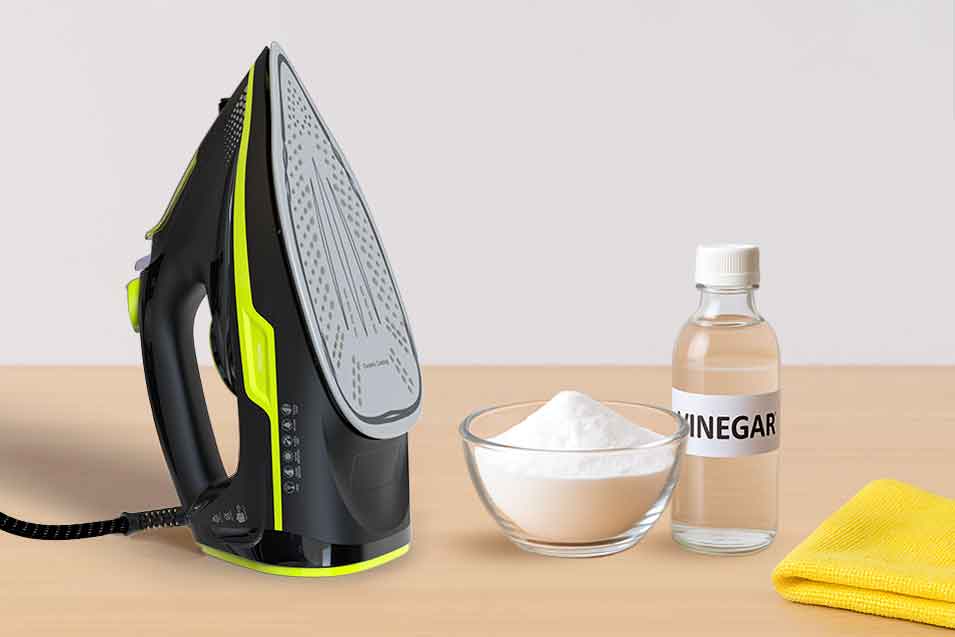
How to Clean Soleplate of Steam Iron: Stepwise Procedure
24th September 2025 | Written By: Utsavi Tank | Read Time: 3min | Last Updated: 24th September 2025
Your everyday steam iron helps to make your garments smooth and professionally finished. However, after a while, its soleplate will accumulate burnt cloth, mineral deposits, or starch and synthetic fibre residue leading to weakening function and even harm to your cloth. To ensure your iron’s smooth gliding function and effective operation, here’s a step-by-step guide to how to safely and effectively clean its soleplate.
Step-by-Step Cleaning Procedure
-
Step 1: Cool It Down:
Switch off your steam iron and let it cool down first before you clean. Safety first always—don’t ever try to clean a hot soleplate.
-
Step 2: Remove Loose Materials:
Get a dry cloth to brush off any free lint, clothing fibres, or dust off the soleplate.
-
Step 3: Prepare a Natural Cleaning Paste:
Combine two tablespoons of baking soda with a few drops of water or white vinegar to make a paste. It gently breaks down stubborn residue without scratching.
-
Step 4: Use the Paste:
Wipe the soleplate covering with a soft cloth or non-metallic sponge. Avoid applying it to steam holes. Allow it to stand for 5–10 minutes to act upon burnt patches or tacky deposits.
-
Step 5: Gently Scrub:
Gently rub soleplate with circular motions only where stained or tacky. For corner or steam holes, a cotton swab lightly moistened with vinegar should be used to rub with caution.
-
Step 6: Wipe Clean:
Dip a dry cloth into water and remove dirt and paste with it. Remove all lingering baking soda or water adhering to the soleplate.
-
Step 7: Toothpaste Buffing:
For occasional shine or stubborn dirt, utilize non-gel toothpaste. Apply a petite quantity on to soleplate, brush softly, and wipe with a damp cloth.
-
Step 8: Dry and Test:
Once rinsed off, let soleplate dry completely. Now plug your iron and roll it down an old towel or piece of cloth to get smooth action and ensure nothing is left behind to mark your garments.
What Not to Do:
- Never use metal scrapers, pins, or knives—these scratch up and destroy non-stick surfaces.
- Clean with soft chemical detergents or acetone.
- Never dunk iron into water.
Additional Tips by Goldmedal: Use distilled water to reduce mineral deposits and plug up steam holes. With a touch of home supplies and periodic maintenance, you can restore your soleplate to almost its pristine state. Regular maintenance increases ironing efficiency but also prevents unwanted staining or scorching on your garments.

Frequently Asked Questions (FAQs) :
- Q1. Can you use salt to clean a burnt steam iron soleplate? Yes, salt will actually clean a burnt soleplate. Shake table salt onto a sheet of newspaper or baking paper and pass the warm (not hot) iron over it. The grittiness of the salt loosens up burnt deposits without strong chemicals. Wipe clean with a damp cloth.
- Q2. What should I do if the soleplate is scratched? Light scratches do not impact performance but can catch on thin fabrics. Polish the soleplate carefully with a non-abrasive cleaner or a baking soda paste. Never use sandpaper or rough scrubbing. If it has deep scratches, a new soleplate or having it done professionally may be necessary to provide smooth gliding.
- Q3. How do you remove melted plastic from a steam iron soleplate? Disconnect the iron and allow it to cool a little until warm. Gently scrape off softened plastic with a wooden spatula or plastic scraper. Be careful not to use metal tools that can scratch. Then clean with a damp cloth and vinegar or a specialized iron cleaner to remove any residue prior to reuse.
- Q4. Does cleaning the soleplate improve ironing efficiency and save electricity? Yes. A soleplate that is clean slides easily across fabrics, minimizing drag and effort. This translates to clothes ironing quicker and at lower temperatures, avoiding multiple passes. Thus, it not only enhances the efficiency of ironing but also lowers electricity consumption, while prolonging the life of the appliance.




